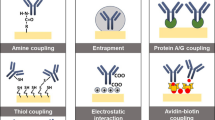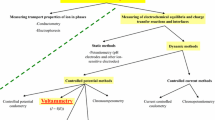Abstract
Single-impact electrochemistry for the analysis of bacteria is a powerful technique for biosensing applications at the single-cell scale. The sensitivity of this electro-analytical method has been widely demonstrated based on chronoamperometric measurements at an ultramicroelectrode polarized at the appropriate potential of redox species in solution. Furthermore, the most recent studies display a continuous improvement in the ability of this sensitive electrochemical method to identify different bacterial strains with better selectivity. To achieve this, several strategies, such as the presence of a redox mediator, have been investigated for detecting and identifying the bacterial cell through its own electrochemical behavior. Both the blocking electrochemical impacts method and electrochemical collisions of single bacteria with a redox mediator are reported in this review and discussed through relevant examples. An original sensing strategy for virulence factors originating from pathogenic bacteria is also presented, based on a recent proof of concept dealing with redox liposome single-impact electrochemistry. The limitations, applications, perspectives, and challenges of single-impact electrochemistry for bacteria analysis are briefly discussed, based on the most significant published data.
Graphical Abstract





Copyright © 2022 Wiley Online Library
Similar content being viewed by others
References
Zhang JH, Zhou YG. Nano-impact electrochemistry: Analysis of single bioentities. TrAC Trends Anal Chem. 2020;123: 115768.
Hu K, Nguyen TDK, Rabasco S, Oomen PE, Ewing AG. Chemical analysis of single cells and organelles. Anal Chem. 2021;93(1):41–71.
Kuss S, Amin HMA, Compton RG. Electrochemical detection of pathogenic bacteria—recent strategies, advances and challenges. Chem – Asian J. 2018;13(19):2758‑69.
Amiri M, Bezaatpour A, Jafari H, Boukherroub R, Szunerits S. Electrochemical methodologies for the detection of pathogens. ACS Sens. 2018;3(6):1069–86.
Kuss S, Couto RAS, Evans RM, Lavender H, Tang CC, Compton RG. Versatile electrochemical sensing platform for bacteria. Anal Chem. 2019;91(7):4317–22.
McCormick HK, Dick JE. Nanoelectrochemical quantification of single-cell metabolism. Anal Bioanal Chem. 2021;413(1):17–24.
Woods LA, Ewing AG. Analysis of single mammalian cells with capillary electrophoresis. Anal Bioanal Chem. 2003;376(3):281–3.
Chen R, Alanis K, Welle TM, Shen M. Nanoelectrochemistry in the study of single-cell signaling. Anal Bioanal Chem. 2020;412(24):6121–32.
Sundaresan V, Do H, Shrout JD, Bohn PW. Electrochemical and spectroelectrochemical characterization of bacteria and bacterial systems. Analyst. 2021;147(1):22–34.
Goines S, Dick JE. Review—electrochemistry’s potential to reach the ultimate sensitivity in measurement science. J Electrochem Soc. 2019;167(3): 037505.
Moussa S, Mauzeroll J. Review—microelectrodes: an overview of probe development and bioelectrochemistry applications from 2013 to 2018. J Electrochem Soc. 2019;166(6):G25-38.
Sekretareva A. Single-entity electrochemistry of collision in sensing applications. Sens Actuators Rep. 2021;3: 100037.
Lebègue E, Anderson CM, Dick JE, Webb LJ, Bard AJ. Electrochemical detection of single phospholipid vesicle collisions at a Pt ultramicroelectrode. Langmuir. 2015;31(42):11734–9.
Dick JE, Lebègue E, Strawsine LM, Bard AJ. Millisecond coulometry via zeptoliter droplet collisions on an ultramicroelectrode. Electroanalysis. 2016;28(10):2320–6.
Lebègue E, Barrière F, Bard AJ. Lipid membrane permeability of synthetic redox DMPC liposomes investigated by single electrochemical collisions. Anal Chem. 2020;92(3):2401–8.
Lebègue E, Costa NL, Louro RO, Barrière F. Communication—electrochemical single nano-impacts of electroactive Shewanella oneidensis bacteria onto carbon ultramicroelectrode. J Electrochem Soc. 2020;167(10): 105501.
Luy J, Ameline D, Thobie-Gautier C, Boujtita M, Lebègue E. Detection of bacterial rhamnolipid toxin by redox liposome single impact electrochemistry. Angew Chem Int Ed. 2022;61(6): e202111416.
Dick JE. Electrochemical detection of single cancer and healthy cell collisions on a microelectrode. Chem Commun. 2016;52(72):10906–9.
Dick JE, Hilterbrand AT, Boika A, Upton JW, Bard AJ. Electrochemical detection of a single cytomegalovirus at an ultramicroelectrode and its antibody anchoring. Proc Natl Acad Sci. 2015;112(17):5303–8.
Smida H, Thobie-Gautier C, Boujtita M, Lebègue E. Recent advances in single liposome electrochemistry. Curr Opin Electrochem. 2022;36: 101141.
Quinn BM, van’t Hof PG, Lemay SG. Time-resolved electrochemical detection of discrete adsorption events. J Am Chem Soc. 2004;126(27):8360‑1.
Xiao X, Fan FRF, Zhou J, Bard AJ. Current transients in single nanoparticle collision events. J Am Chem Soc. 2008;130(49):16669–77.
Sepunaru L, Tschulik K, Batchelor-McAuley C, Gavish R, Compton RG. Electrochemical detection of single E. coli bacteria labeled with silver nanoparticles. Biomater Sci. 2015;3(6):816‑20.
Dunevall J, Fathali H, Najafinobar N, Lovric J, Wigström J, Cans AS, et al. Characterizing the catecholamine content of single mammalian vesicles by collision-adsorption events at an electrode. J Am Chem Soc. 2015;137(13):4344–6.
Dick JE, Renault C, Bard AJ. Observation of single-protein and DNA macromolecule collisions on ultramicroelectrodes. J Am Chem Soc. 2015;137(26):8376–9.
Deng Z, Elattar R, Maroun F, Renault C. In situ measurement of the size distribution and concentration of insulating particles by electrochemical collision on hemispherical ultramicroelectrodes. Anal Chem. 2018;90(21):12923–9.
Farooq A, Butt NZ, Hassan U. Circular shaped microelectrodes for single cell electrical measurements for lab-on-a-chip applications. Biomed Microdevices. 2021;23(3):35.
Gao G, Wang D, Brocenschi R, Zhi J, Mirkin MV. Toward the detection and identification of single bacteria by electrochemical collision technique. Anal Chem. 2018;90(20):12123–30.
Lee JY, Kim BK, Kang M, Park JH. Label-free detection of single living bacteria via electrochemical collision event. Sci Rep. 2016;6:30022.
Ronspees AT, Thorgaard SN. Blocking electrochemical collisions of single E. coli and B. subtilis bacteria at ultramicroelectrodes elucidated using simultaneous fluorescence microscopy. Electrochim Acta. 2018;278:412‑20.
Smida H, Lefèvre FX, Thobie-Gautier C, Boujtita M, Paquete CM, Lebègue E. Single Electrochemical Impacts of Shewanella oneidensis MR-1 Bacteria for Living Cells Adsorption onto a Polarized Ultramicroelectrode Surface. ChemElectroChem. 2023;10(1): e202200906.
Couto RAS, Chen L, Kuss S, Compton RG. Detection of Escherichia coli bacteria by impact electrochemistry. Analyst. 2018;143(20):4840–3.
Chen Y, Wang D, Liu Y, Gao G, Zhi J. Redox activity of single bacteria revealed by electrochemical collision technique. Biosens Bioelectron. 2020;176: 112914.
Chen Y, Liu Y, Wang D, Gao G, Zhi J. Three-mediator enhanced collisions on an ultramicroelectrode for selective identification of single saccharomyces cerevisiae. Anal Chem. 2022;94(37):12630–7.
Deng Z, Renault C. Detection of individual insulating entities by electrochemical blocking. Curr Opin Electrochem. 2021;25: 100619.
Thorgaard SN, Jenkins S, Tarach AR. Influence of electroosmotic flow on stochastic collisions at ultramicroelectrodes. Anal Chem. 2020;92(18):12663–9.
Frkonja-Kuczin A, Ray L, Zhao Z, Konopka MC, Boika A. Electrokinetic preconcentration and electrochemical detection of Escherichia coli at a microelectrode. Electrochim Acta. 2018;280:191–6.
Wang X, Clément R, Roger M, Bauzan M, Mazurenko I, de Poulpiquet A, et al. Bacterial respiratory chain diversity reveals a cytochrome c oxidase reducing O2 at low overpotentials. J Am Chem Soc. 2019;141(28):11093–102.
Thet NT, Jenkins ATA. An electrochemical sensor concept for the detection of bacterial virulence factors from Staphylococcus aureus and Pseudomonas aeruginosa. Electrochem Commun. 2015;59:104–8.
Roehrich B, Liu EZ, Silverstein R, Sepunaru L. Detection and characterization of single particles by electrochemical impedance spectroscopy. J Phys Chem Lett. 2021;12(40):9748–53.
Acknowledgements
This work is supported by Nantes Université and Région Pays de la Loire (Rising stars program, e-NANOBIO).
Author information
Authors and Affiliations
Corresponding author
Ethics declarations
Conflict of interest
The authors declare that they have no conflict of interest.
Additional information
Publisher's note
Springer Nature remains neutral with regard to jurisdictional claims in published maps and institutional affiliations.
Published in the topical collection Young Investigators in (Bio-)Analytical Chemistry 2023 with guest editors Zhi-Yuan Gu, Beatriz Jurado-Sánchez, Thomas H. Linz, Leandro Wang Hantao, Nongnoot Wongkaew, and Peng Wu.
Rights and permissions
Springer Nature or its licensor (e.g. a society or other partner) holds exclusive rights to this article under a publishing agreement with the author(s) or other rightsholder(s); author self-archiving of the accepted manuscript version of this article is solely governed by the terms of such publishing agreement and applicable law.
About this article
Cite this article
Smida, H., Langlard, A., Ameline, D. et al. Trends in single-impact electrochemistry for bacteria analysis. Anal Bioanal Chem 415, 3717–3725 (2023). https://doi.org/10.1007/s00216-023-04568-z
Received:
Revised:
Accepted:
Published:
Issue Date:
DOI: https://doi.org/10.1007/s00216-023-04568-z




